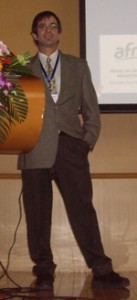 Food & Function Editorial Board member, Alejandro Marangoni recently spoke at the Unilever-RSC International Symposium on Functional Materials. This series of three one day meetings was held from the 8th-11th November in Beijing, Hangzhou and Shanghai. Alejandro’s first two talks focussed on nanoscale structures in fats and his final one on nanostructuring liquid oils into functional fats.
Food & Function Editorial Board member, Alejandro Marangoni recently spoke at the Unilever-RSC International Symposium on Functional Materials. This series of three one day meetings was held from the 8th-11th November in Beijing, Hangzhou and Shanghai. Alejandro’s first two talks focussed on nanoscale structures in fats and his final one on nanostructuring liquid oils into functional fats.
 Sensory attributes of fat structure materials such as butter and chocolate are mainly related to the structure and properties of a network of triacylglycerols, polycrystals and crystal aggregates present. Alejandro described the nanoscale structure and intercrystalline interactions in chocolate which explain its pleasures. His group have discovered that the general structure of a fat crystalline network starts with the association of nanoplatelets at the lowest structural level. These nanoplatelets interact and aggregate via van der Waals’s forces into larger fractal structures to form a three-dimensional matrix. These new insights are contributing to the knowledge of the nature of fat crystal networks and the relationship between these structures to the functional properties of edible fats.
Sensory attributes of fat structure materials such as butter and chocolate are mainly related to the structure and properties of a network of triacylglycerols, polycrystals and crystal aggregates present. Alejandro described the nanoscale structure and intercrystalline interactions in chocolate which explain its pleasures. His group have discovered that the general structure of a fat crystalline network starts with the association of nanoplatelets at the lowest structural level. These nanoplatelets interact and aggregate via van der Waals’s forces into larger fractal structures to form a three-dimensional matrix. These new insights are contributing to the knowledge of the nature of fat crystal networks and the relationship between these structures to the functional properties of edible fats.
 Alejandro’s last talk reviewed novel strategies for nanostructuring liquid oils into functional fats. This is an area of increasing interest due to public concerns over excessive saturated and trans fat intake from manufactured food products. Alejandro described various strategies: using surfactant-like small molecules, phytosterols and ceramides as organogelators, structuring liquid oils by microencapsulation within multilamellar vesicles and the use of high-molecular weight polymers such as ethylcellulose to gel oil in the absence of water.
Alejandro’s last talk reviewed novel strategies for nanostructuring liquid oils into functional fats. This is an area of increasing interest due to public concerns over excessive saturated and trans fat intake from manufactured food products. Alejandro described various strategies: using surfactant-like small molecules, phytosterols and ceramides as organogelators, structuring liquid oils by microencapsulation within multilamellar vesicles and the use of high-molecular weight polymers such as ethylcellulose to gel oil in the absence of water.
Do you work in this field? Submit your work to Food & Function today!










